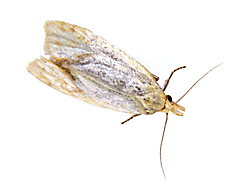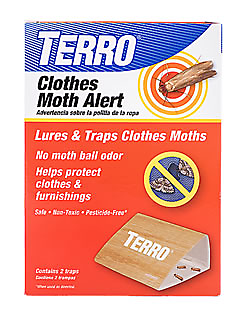Common Clothes Moth Species: Webbing Clothes Moths

The webbing clothes moth is a common moth, especially in the northern part of the country. Often you are not aware there is a problem until its too late, meaning an infestation is already in progress.
Appearance
Like many moths, webbing clothes moths tend to fly around the area of infestation, they like to stay close. Weak at flying, these moths have a spotty flight pattern and really flutter more so than fly.
Key physical characteristics of the webbing clothes moth include:
- Shimmery gold, sometimes cream body
- Red or golden little hairs along their head
- Grows up to ¼ long, ½ inch wingspan
- Clustering around a certain area
- They distinctly flutter around vs. truly flying
- Larvae produce silk webs
- Silk webs also used as feeding tubes are left behind as they search for another location to feed
Habitat
Webbing clothes moths are usually found in dark and undisturbed areas of closets, dressers, and furniture.
Geography
As the most common moth, webbing clothes moths are found all over the world. It is said these moths have both European and South African origins.
Diet
Webbing clothes moths consume natural fibers that are found in every household. Moths don’t drink water as they obtain moisture from liquids like sweat and other stains on clothing.
This moth species eats the following:
- Natural fibers
- Wool
- Cashmere
- Carpets
- Upholtered furniture
- Organic fibers
Threat
In general, clothes moths all have the same agenda and given threat: to destroy fabrics in the home. This can be time consuming to deal with and can cause you to spend a lot of money to replace clothing and even furniture. With the rate that these moths can multiply while going un-noticed for some time, an infestation is likely to occur before you realize there is a problem.
Control Options

- Trap the Moths: For easy clothes moth control, try our safe and non-toxic, TERRO® Clothes Moth Traps. Simply place the moth traps in areas where moths are observed. These traps contain a powerful pheromone lure that attracts moths to the trap’s sticky surface where they get stuck and die.
- Wash All Clothing & Linens: Before storing fabrics ensure they are thoroughly washed to remove stains, spills or sweat that attract and feed the moths.
- Vacuuming: Vacuum to remove moth eggs that you can’t see hiding in carpets and drapes. Also, vacuum out the closet and drawers where clothes are stored.
- Cedar Storage: Cedarwood contains natural oils that kill the larvae of clothes moths. Cedarwood blocks, hangers or even cedar chests are great aids in preventing infestations.
- Keep Fabrics Airtight: Fabrics that such as wool should be stored in airtight bags/containers to prevent access to the moths.
